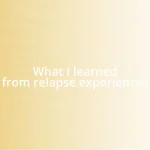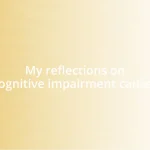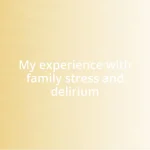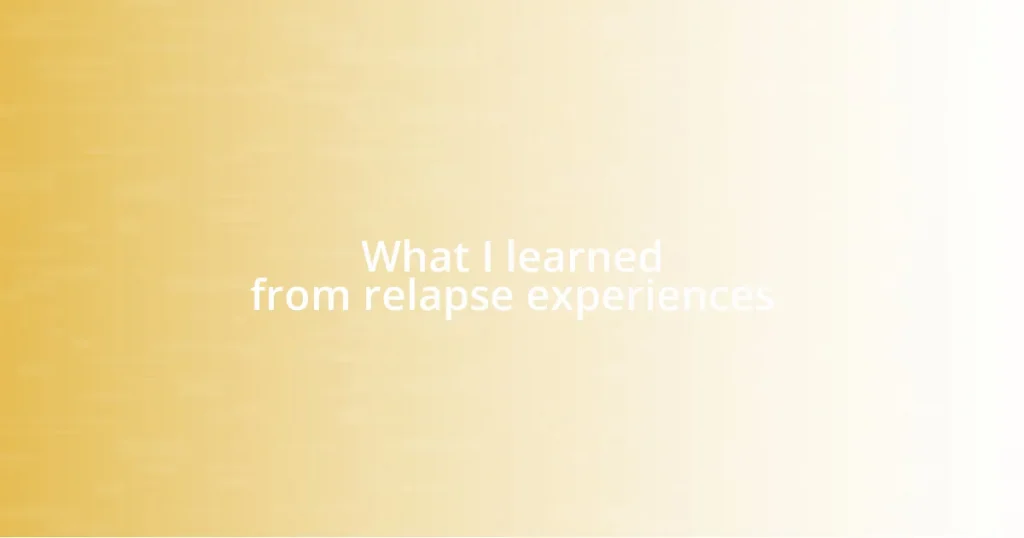Key takeaways:
- Environmental factors such as lighting, noise levels, familiarity, and temperature significantly influence the onset and severity of delirium.
- Creating a calm and supportive environment, including soft lighting and manageable noise, can reduce patient agitation and promote recovery.
- Future research should focus on the impact of natural light, sound environments, and patient feedback to optimize healing spaces.
- Personalization of patient surroundings can empower individuals and enhance their mental clarity during recovery from illness.

Understanding delirium triggers
Delirium triggers can often unfold in surprising ways, reflecting the unique vulnerabilities of each individual. I remember a time when a loved one suddenly became disoriented after a simple medication change. It made me question how seemingly minor adjustments could lead to such profound confusion and distress.
Environmental factors play a significant role in the onset of delirium as well. Have you ever noticed how a noisy hospital room can heighten feelings of anxiety or agitation? I’ve seen patients become increasingly irritable simply because they lacked a familiar, quiet space that felt comforting. It underscores how essential it is to create a calm environment—one that respects the patient’s need for peace.
Moreover, changes in routine, like disrupted sleep cycles or lack of natural light, can be subtle yet powerful triggers. I’ve personally witnessed how a well-placed window can uplift a patient’s mood and clarity. Why is it that something as simple as sunlight can have such a profound effect? It’s a reminder that our surroundings shape our mental states in ways we often overlook.

Role of environmental factors
Environmental factors can drastically influence the onset and severity of delirium. For instance, I recall a situation where a patient was recovering in a dimly lit room, seemingly unaware of the world outside. The absence of natural light not only contributed to their disorientation but also made them feel trapped. This experience highlighted for me how critical a bright, engaging space can be for clarity of mind and emotional well-being.
Consider these key environmental factors that influence delirium:
- Lighting: Natural light can boost mood and orientation, while darkness can confuse.
- Noise Levels: A quiet environment fosters calmness, whereas loud or chaotic sounds can heighten anxiety.
- Familiarity: Surroundings that patients recognize, like personal items or family photos, can provide comfort and reduce confusion.
- Temperature Regulation: Adequate warmth can promote relaxation; extreme temperatures can lead to discomfort and restlessness.
- Routine and Structure: Maintaining a consistent daily schedule can help anchor patients and provide a sense of stability.
It’s fascinating how much our surroundings can affect our mental states, isn’t it?

Impact of noise on delirium
The impact of noise on delirium is often underestimated. I can’t help but recall the time when I visited a busy ICU where the persistent beeping of machines and ringing of phones created a symphony of chaos. It was stressful not just for the staff but for the patients, too. I saw firsthand how the continuous noise disrupted their ability to rest, pull together their thoughts, and feel grounded in reality.
Sometimes, the effect of noise can be subtle yet profound. During one visit, I noticed a patient becoming increasingly agitated with every loud voice echoing down the hall. It occurred to me that it’s not just the volume of sound we need to consider, but also the types of noises. In quieter spaces, familiar sounds, like the gentle rustling of pages or the soft tapping of keyboards, can create a reassuring environment. This made me realize that curating sounds, in addition to reducing noise, is crucial for patient well-being.
In my experience, creating an environment with controlled sound levels can significantly reduce incidents of delirium. Simple interventions, like soft background music or quiet chatter, can promote relaxation while eliminating abrupt, unsettling noises. I often encourage caregivers to be mindful of their volume, knowing how a calm voice can foster a sense of security. Have you pondered how much a serene environment contributes to recovery? It’s quite powerful when you think about how ambient noise can shape a person’s state of mind.
| Noise Levels | Impact on Delirium |
|---|---|
| High Noise Levels | Increased anxiety and agitation |
| Moderate Noise Levels | May promote some distraction, but can still contribute to confusion |
| Low Noise Levels | Fosters calmness and facilitates recovery |

Lighting effects on mental state
I’ve often found that lighting can significantly impact our mental state, especially in vulnerable situations like recovery from illness. For example, while spending time in a rehabilitation unit, I observed a patient gradually awaken from a stupor as daylight streamed through the windows. It was such a simple thing, yet it seemed to illuminate not just the room but also her spirit, fostering a sense of awareness that had been absent in the gloom of evening. How powerful is that stark contrast, right?
In my experience, harsh fluorescent lights can feel sterile and disheartening, sapping energy and promoting confusion. I remember visiting a friend in a hospital where overhead lights were left on all night. It created an oppressive atmosphere that left her feeling anxious and restless rather than relaxed and safe. The change to softer, warmer lighting during later hours made a noticeable difference; she said it helped her feel more at ease, allowing sleep to reclaim its rightful place in her recovery. Isn’t it fascinating how something as basic as lighting can alter perception and recovery?
Natural light, particularly, has always amazed me. I can vividly recall how a well-placed window, allowing sunshine to pour in, transformed a sterile room into a nurturing space. Patients often remarked about how those golden rays lifted their spirits and helped them reconnect with reality. It reminds me of how much we overlook simple elements that nurture our mental health. Have you considered how ambiance affects your mood? I believe it plays a crucial role, and it’s something we can all be more mindful of in our environments.

Temperature influence on brain function
Temperature is another critical factor that can profoundly influence brain function and overall mental clarity. I often think back to a time in a particularly hot hospital ward, where the air felt thick and oppressive. The sweat beading on patients’ brows wasn’t just a discomfort; it was a clear indicator that the heat might be interfering with their mental sharpness. As the temperature climbed, I noticed some patients seemed more confused and less engaged, almost as if they were drifting away on a tide of heat-induced haze. Isn’t it interesting how a simple shift in temperature can pull us into a mental fog?
Conversely, I’ve come across chilling environments where discomfort reigned supreme. I remember visiting a facility where the air conditioning was set to a frigid setting, making everyone bundle up in thick blankets just to feel somewhat comfortable. Despite their physical warmth, I could see the effects of that cold temperature on their emotions and cognition. There was a layer of irritability and distraction that permeated the room as patients struggled to focus on conversations or therapies. Have you ever found it hard to think clearly when you’re too cold? It’s as if our brains are telling us to focus on survival instead of clarity.
From my perspective, balancing temperature is essential for fostering a conducive healing environment. I often suggest a personal touch, like allowing patients to control their immediate surroundings where possible, whether it’s adjusting the thermostat or bringing in a cozy blanket. This not only empowers them but also helps them feel more in control of their recovery, creating a psychologically supportive space. I truly believe that when we consider temperature management, we can significantly enhance cognitive function and reduce the risk of delirium—it’s a simple yet effective step we can take.

Optimizing patient surroundings
Creating a supportive atmosphere goes beyond just lighting or temperature; it’s about the overall environment surrounding patients. I once walked into a room that was adorned with calming artwork and personal items that belonged to the patient. The moment I stepped inside, I felt the warmth and familiarity emanating from those small touches. It’s incredible how visual elements can evoke emotions and memories that ground us in reality during challenging times, don’t you think?
In my experience, sound levels also play a crucial role in a patient’s well-being. I can recall a time when I was visiting a loved one in a care facility. The cacophony of alarms, chatter from staff, and distant conversations was overwhelming. It was as if the sound was penetrating my very soul, creating a sense of chaos. But then the staff decided to implement “quiet hours,” significantly reducing noise. The change was like a balm; suddenly, the room felt more serene, allowing for moments of clarity and connection. Isn’t it remarkable how something so easily managed can enhance comfort in such a profound way?
I’ve also found that keeping patient surroundings decluttered can make a world of difference. I remember a particularly chaotic room filled with medical equipment and magazines stacked high. The clutter not only felt distracting but also created a sense of helplessness for the patient. When I suggested organizing the space, we created a cleaner, more open environment that felt much more inviting. It’s a simple observation, but streamlining one’s surroundings can truly foster clarity and tranquility. How do you feel in spaces that allow for some order versus those that are chaotic? I believe that our environments should promote peace, not confusion.

Future research directions in delirium
Exploring future research directions in delirium opens up a world of potential discoveries. I often think about the importance of multidisciplinary studies that examine variables such as light exposure, sound environments, and even the colors in a patient’s room. During one of my visits to a research facility, I witnessed a pilot study focusing on natural light’s effects on patients’ moods. The optimistic energy in the rooms bathed in sunlight was palpable. Isn’t it fascinating how something as simple as adding daylight exposure can potentially reduce delirium episodes?
Additionally, I’m curious about the role of technology in monitoring environmental factors that influence cognitive function. Imagine wearable devices that track patients’ responses to temperature changes or noise levels in real-time. In my experience, finding ways to utilize technology for proactive monitoring could significantly change the way we approach the management of delirium. Have you considered how smart technology might offer insights into creating a more comforting environment? It feels like an exciting frontier in healthcare.
Lastly, I believe we need more studies that incorporate patient feedback regarding their surroundings. Gathering insights directly from patients about how they feel in specific environments could offer profound revelations. I often think about my conversations with patients who shared their desire for personalization in spaces they inhabit during recovery. Those small voices can have a monumental impact on our understanding of effective delirium interventions. How can we empower patients to shape their environments to foster their healing further? Understanding their perspective might just lead us to solutions we haven’t yet imagined.















